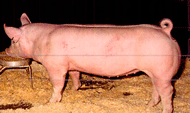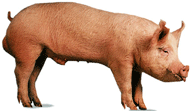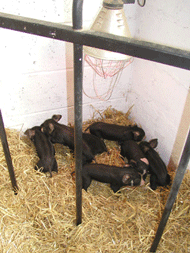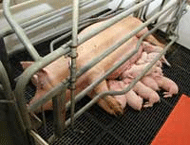Piggery
Piggery
Introduction to pig farming
Advantages of pig rearing
- Pigs convert inedible feeds, forages, certain grain byproducts obtained from mills, meat by products, damaged feeds and garbage into valuable nutritious meat. Most of these feeds are either not edible or not very palatable to human beings
- Pig grows fast and is a prolific breeder, farrowing 10 to 12 piglets at a time. It is capable of producing two litters per year under optimal management conditions
- The carcass return is quite high ie. 60-80 percent of live body weight
- With a small investment on building and equipment, proper feeding and sound disease control programme the farmer can profitably utilize his time and labour in this subsidiary occupation
- The faeces of pigs is used as a manure to maintain soil fertility
Pig farming- for whom?
- Small and landless farmers
- Part time earning for educated youth having agriculture as occupation
- uneducated youth
- Farm women
Breeding Management
|
Age to breed gilts |
8 months |
|
Weight of breed gilts |
100-120 kg |
|
Length of heat period |
2-3 days |
|
Best time to breed in heat period |
Gilts – first day Sows- Second day |
|
Number of services per sow |
2 services at an interval of 12-14 hours |
|
Period of oestrous cycle |
18-24 days (Average 21 days) |
|
Occurrence of heat after weaning |
2-10 days |
|
Gestation period |
114 days |
Selection of breeding stock
Important characteristics which need to be considered in developing a good sow herd are
- Size of litters
- Strength and vigour of litters
- Milking ability
- Temperament
Gain and feed efficiency, fertility, selection of individual animals from a herd is more important than the selection of a particular breed. Each producer at the time of setting up his herd should purchase his animals from a reliable disease free herd and should obtain as much information of the animals as possible. Once the herd is established the selection of the gilts and boars for replacement in the breeding herd should be based on the types and performance.
Selection of gilts (female)

- Selection of gilts for the breeding herd should be made at market weight ie. When the animals weigh about 90 kg
- Select gilts from sows which have consistently farrowed and weaned large litters
- They have reached market in minimum time and have desirable market type
- It would be desirable to choose gilts whose litter mates and other fullsibs have given good performance in daily weight gain and feed conversion efficiency
Selection of boars (male)

- Selection of boar is extremely important, particularly for a small breeding farm or unit
- The boar should be purchased from a breeder or a farm maintaining adequate information on its performance
- The boar should be selected from a dam which has consistently farrowed and weaned high litters
- A good boar will weigh 90 kg in about 5-6 months will be of good type and will be strong on feet and legs
- The feed conversion from weaning to 90 kg weight would be the most desirable.
Points to be considered while replacing boars and gilts
- The mother of the pig to be selected should have had large litters of 8 piglets or more. The weaning weight (at 56 days) of a litter in case of a gilt selection should have been 120 kg and in the case of sow it should not less than 150 kg
- The gilt or the boar should have reached a body weight of about 90 kg in about 6 months
- The pig should have adequate length and depth of the body, thick well muscled hams should be firm and trim
- The pig should have sound feet and legs
- The back fat prove in live animals is not yet being practiced in this country. For gilt back fat thickness of 4 cm or less, boars 3.2 or less
- Gilts should have a minimum of 12 evenly spaced, functional teats. An animal with blind teats should be avoided as there will be little or no milk from these teats and the defect is heritable
- Negative blood test for both brucellosis and leptospirosis should be made during selection and the pigs should be vaccinated against swine fever
- Pigs should be free from other diseases and physical defects
Age of breeding stock
Well developed gilts may as a general rule bred to farrow when 12-14 months old. This depends more on development than on age. Gilts should weigh at least 100 kg before breeding. Ovulation rate increases during successive oestrous periods (up to fifth) following puberty. Thus it is advantageous to delay the breeding of gilts until the second or third oestrous. Litter size increases on an average in succeeding pregnancies up to 5th or 6th litter. It is therefore advantageous to cull the sow from a breeding herd or a commercial herd after her fifth or sixth litter as the litter size goes down thereafter.
Detection of heat
The average length of oestrous cycle in pigs is 21 days. The oestrous symptoms last for five to seven days beginning with vulvar swelling and vaginal discharge. In true oestrous there is frequent urination, reduced appetite, mounting and standing for service detected by the erection of ears and immobility when normal pressure is applied to the back. The application of pressure on the back is used to determine the correct breeding time. Animals with a predisposition for weak oestrous should be brought near the boar to exhibit heat symptoms a little more clearly.
Best time for breeding is during the latter half of the first day or early on the second day of oestrous. In many cases the gilts and sows continue to exhibit the standing heat on the next day. In these cases the animals should be rebred and the interval in the case of rebreeding should be 12-14 hours. This procedure will ensure a high conception rate in the herd.
Sows come into oestrous one to four days after farrowing but they should not be bred at this time. Sows may also come into heat two to ten days after weaning and may be bred at this time. But better results can be obtained by breeding them in the second post lactational oestrous. The animals which have been bred should be observed for the appearance of subsequent oestrous. If sows not conceived even after successful mating with a boar in two continous oestrous cycles it is desirable to cull them from the herd.
Flushing
It is the method of feeding sows and gilts before breeding. A good grower ration fed to sows and gilts seven to ten days before breeding is helps in increased ovulation rates in them. After breeding sows and gilts should be fed a limited but well balanced ration until the last six weeks of pregnancy and then full feeding should be resumed.
Care and management of pregnant animals
The gestation period of sow varies from 109-120 days with an average of 114 days. Pregnant animals should be housed in groups in separate enclosures and should not be mixed with new animals to avoid fighting which at times may result in abortion. It would also be advisable to house pregnant gilts and sows in separate groups during gestation. About 3 m2 of dry housing should be available for each sow. The pregnant animals should be allowed to move about every day in the morning on a free range or a pasture if available. A pasture area is presumed to be clean if a cultivated crop was raised.
Management at farrowing
Farrowing time is the critical time in pig production. Death rate is high during farrowing and the first week after farrowing. Sows may be farrowed in pens equipped with guard rails and a creep space in farrowing crates or in farrowing stalls. A pen equipped with guard rails and a creep space is adequate. The pen should be maintained at 24ºC to 28ºC until the piglets are three or four days old and at 18ºC to 22ºC until the piglets are approximately six weeks old. The heat lamps should be hung 45 cm from the floor and suitably protected. The farrowing pens should be thoroughly cleaned before the sow is brought in. This will prevent a large number of diseases of piglets. The sow should brought to the farrowing pen atleast one week prior to farrowing so that it becomes familiar with the surroundings. She should be washed thoroughly before being brought to the farrowing pen. The feed ration should be made bulky by substituting one-third of the regular ration with wheat bran. The amount of ration fed should also be reduced by one third till the sow farrows. The sow should be watched closely for determining the approximate time of farrowing and feed should not be given 12 hours before farrowing.
Care during farrowing
An attendant should be on hand when the sow farrows. Otherwise many piglets will die. It takes generally 2 to 4 hours for complete farrowing to take place. The piglets should be removed as they are farrowed and kept warm in the creep space until farrowing is complete. Each piglet should be cleaned of all mucus to ensure that the breathing passages are clear. The navel cord should be tied 2-5 cm away from the navel, cut with a disinfected pair of scissors and the stumps painted with iodine. Piglets should be allowed to be nursed after birth. In about 2 days they settle down to their individual teats. They nurse 8-10 times in 24 hours in the initial period. Trampling by the sow should be prevented during the first two weeks.
Care and management of piglets
Removal of needle teeth
Piglets are born with four pairs of sharp teeth, with two pairs on each jaw. They are of no practical value to the piglets and they may irritate the sow’s udder during nursing or cause injury to other piglets. Clipping of these teeth shortly after birth will prevent the injury of the udder caused by the needle teeth.
Anaemia in piglets
Anaemia is a common nutritional disease in piglets. This condition can be prevented and cured by supplying iron either orally or by injection. Oral administraion consists of spraying or swabbing the sow’s udder with a saturated solution of ferrous sulphate (0.5 kg of ferrous sulphate in 10 litres of hot water). This solution must be applied daily from birth until the piglets start eating creep feed. Intra muscular infection of iron –dextran compounds is the more effective method of preventing anaemia.
Raising orphan piglets
The death of a sow after farrowing, mastitis, lactation failure of litters larger than the sow is able to raise, result in orphan pigs. If another sow has farrowed within a short time previously, the orphan piglets may be transferred to her. This transfer must be made within a few days after farrowing because those section of sow’s udder are not used soon cease producing milk. To ensure acceptance of new pigs the sow should be separated from her own litter for short time and then the new piglets are brought to her and a disinfectant or other material sprinkled on all the piglets to mask the odours.
Orphan piglets can also be raised with milk replacer. Milk replacer consists of one egg yolk thoroughly mixed with one litre of cow milk. This mixture supplies a well balanced diet except for iron. To compensate for the lack of iron one eighth teaspoonfull of ferrous sulphate may be added to one litre of milk. An injection with iron compound may also be used.
Castration
The male piglets not selected for breeding may be castrated when they are three to four weeks old.
Separation of piglets from mother (Weaning)
Normal weaning age of piglets is at 8 weeks age. The sow should be separated from the piglets for a few hours each day to prevent stress of weaning and feed is reduced gradually. The piglets should be dewormed after 2 weeks of weaning. The piglets should be gradually shifted from 18 percent protein creep feed to 16 percent grower ration over a period of two weeks. Group of 20 piglets of more or less the same age should be housed in each pen.
Feeding Management of pigs
Points to be considered while formulating feeding ration
- Most economical ingredients should be selected
- Grains- maize, sorghum, oat, other millets, wheat and rice should form the basic ingredients
- Protein supplements - oil cakes and fishmeal and meat meal
- No vitamin supplements is necessary if the pigs are allowed to pasture or are fed fresh green legumes. Vitamin B 12 supplement would be necessary if little or no animal protein is fed
- Antibiotic supplements at the rate of 11 mg of antibiotic per kilogram of ration
- Mineral supplements should be provided
The following table gives specifically the various requirements in the formation of creep, grower and finisher rations for pigs.
|
Nutrients |
Creep feed (Up to weaning) |
Grower ration (20-40 kg) |
Finisher ration (40-90 kg) |
|
Protein supplement (%) Oilcakes |
16-18 |
14-16 |
13-14 |
| Animal protein |
8-10 |
4 |
2 |
|
Grains (Maize, sorghum, millets or combination of grains) (%) |
60-65 |
50-55 |
40-50 |
|
Wheat bran or rice bran (%) |
5 |
10 |
20 |
|
Lucerne meal (%) if available |
-- |
5-8 |
-- |
|
Mineral mixture(%) |
0.5 |
0.5 |
0.5 |
|
Antibiotic supplement (mg) |
40 |
20 |
10 |
The composition of the concentrate feed for various age groups pigs
|
Ingredients |
Creep feed (14th to 56th day |
Grower ration (up to 40 kg) |
Finisher ration(40-90 k.g) |
Pregnant and nursing sows |
|
Maize or sorghum or broken wheat, broken rice and barley in convenient combinations |
65 |
50 |
50 |
50 |
|
Oil cakes (groundnut oil cake, soya bean oil-cake, sesame oil cake, linseed oilcake |
14 |
18 |
20 |
20 |
|
Molasses |
5 |
5 |
5 |
5 |
|
Wheat bran or rice bran |
10 |
1.5 |
25 |
18 |
|
Fishmeal or meat meal or cooked offal, skim milk powder dairy wastes |
5 |
5 |
3 |
5 |
|
Mineral mixture |
1 |
1.5 |
1.5 |
1.5 |
|
Salt |
-- |
0.5 |
0.5 |
0.5 |
The most convenient way to feed animals on a farm is to prepare the complete ration recommended for different classes and give the pigs the amount they will eat without waste two or three times daily. The following is the approximate amount of dry feed the pigs will consume.
|
Weight of pig (kg) |
Daily consumption of feed (kg) per pig |
|
25 |
2.0 |
|
50 |
3.2 |
|
100 |
5.3 |
|
150 |
6.8 |
|
200 |
7.5 |
|
250 |
8.3 |
All grains in mixed feeds should be ground. Generally feeding in the form of wet mash is not superior than (Slop feeding) dry feeding. Slop feeding requires more time and excessive labour. If a ration is fairly high in fibre, pelleting the feed may increase the rate and efficiency of gain in weight. Pelleting may also decrease the amount of feed that is wasted.
It is important not to overfeed sows which have been bred. Over fat sows are apt to produce weak pigs and crush more piglets at farrwoing. Sows should gain about 35 kg and gilts about 55 kg from breeding to farrowing.
Housing management of pigs
Adequate housing and equipment for raising pigs are necessary to provide shelter against inclement weather, prevent diseases, control parasites and save labour.
The normal requirement of floor area, water and air space in pens for various classes of pigs is given below
|
Class of animals |
Covered floor area per animal (m2) |
Open-yard area per animal (m2) |
Water required (litres) |
|
Boar |
6.25-7.5 |
8.8-12.0 |
45.5 |
|
Farrowing |
7.5-9.0 |
8.8-12 |
18-22 |
|
Weaner |
0.96-1.8 |
8.8-12 |
3.5-4 |
|
Dry sow |
1.8-2.7 |
1.4-1.8 |
4.5-5 |
Creep space
The flooring should have a rough finish and should be be of a regular masonary type made up of water proof cement mortar. Proper drains should be provided so that the effluents are disposed off. Generally under village conditions the housing can be made up of pens measuring 3 m X 2.4 m or 3 m X 3 m with an open yard of nearly the same dimension or in some cases slightly longer. Walls should be 1.2-1.5 m high from the floor. For the purposes of farrowing some of the pens could be converted into farrowing pens by providing guard rails made up of G.I pipes of 5 cm diameter, along the walls, 20-25 cm from the ground and the wall. In addtion to guard rails, creep space can be provided for the piglets along the wall by making a partition or in one of the corners with separate entrances for the piglets. This space usually of 0.75 m X 2.4 m area. In many of the farms the yard is provided with regular flooring.

Prolonged exposure of exotic breeds of pigs to bright sunshine may cause pigs to become overheated even during moderate weather. Shade helps in preventing deaths and increasing production effeciency during hot weather. While it is desirable to plant trees in the neighbourhood of pens for reducing the intensity of heat. But it is not desirable to plant trees for giving regular shade because they permit rapid build up of parasite levels.
Farrowing Pen

Wallows
Pigs have very few sweat glands. In areas having warm weather mature breeding animals and fattening animals need a wallow during summer months. Instead of permitting unsanitary wallows a masonry wallow with proper drainage would be desirable. The size of the wallow will depend upon the number and size of the animals.
Prevention and control of pig diseases
- All pigs should be vaccinated against swine fever at the age of 2-4 weeks. Breeding pigs should be tested for brucellosis and leptospirosis. As a routine measure all young pigs at the time of weaning should be inoculated against swine fever.
- Animals purchased for the farm should be purchased from disease free herds. Newly purchased animals should be isolated from the other animals in the farm for a period of three to four weeks. No visitor allowed visiting the farm. Those stys or pig houses cleared of the animals are kept empty for three to four weeks for destruction of microorganisms causing the disease.
Source : Pig Farming, ICAR Handbook on Animal Husbandry
Related Resources
Last Modified : 12/15/2021
This topic provides about *99# Service- Innovative...
This topic provides information about Zero tillage...
This topic provides information related to steps t...
Important activities one should take care in dairy...
